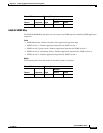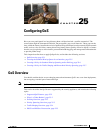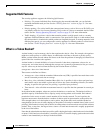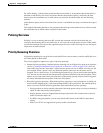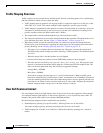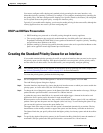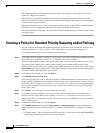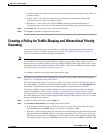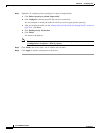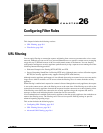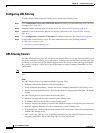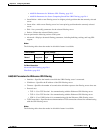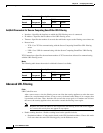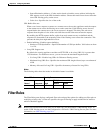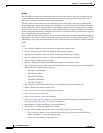
25-7
Cisco ASDM User Guide
OL-16647-01
Chapter 25 Configuring QoS
Creating a Policy for Traffic Shaping and Hierarchical Priority Queueing
• Conform Action—The action to take when the rate is less than the conform-burst value. Values are
transmit or drop.
• Exceed Action—Take this action when the rate is between the conform-rate value and the
conform-burst value. Values are transmit or drop.
• Burst Rate—A value in the range 1000-512000000, specifying the maximum number of
instantaneous bytes allowed in a sustained burst before throttling to the conforming rate value.
Step 8 Click Finish. The service policy rule is added to the rule table.
Step 9 Click Apply to send the configuration to the device.
Creating a Policy for Traffic Shaping and Hierarchical Priority
Queueing
You can configure traffic shaping for all traffic on an interface, and optionally hierarchical priority
queueing for a subset of latency-sensitive traffic. See the “How QoS Features Interact” section on
page 25-4 for information about valid QoS configurations.
Note One side-effect of priority queueing is packet re-ordering. For IPSec packets, out-of-order packets that
are not within the anti-replay window generate warning syslog messages. These warnings are false
alarms in the case of priority queueing. You can configure the IPSec anti-replay window size to avoid
possible false alarms. See the Configuration > VPN > IPSec > IPSec Rules > Enable Anti-replay window
size option in the “Crypto Maps” section on page 34-9.
To configure a QoS service policy, perform the following steps:
Step 1 Configure a service policy on the Configuration > Firewall > Service Policy Rules pane according to
Chapter 22, “Configuring Service Policy Rules.”
You can configure QoS as part of a new service policy rule, or you can edit an existing service policy.
For traffic shaping, all traffic on an interface must be shaped. You can only use the class-default class
map, which is automatically created by the security appliance, and which matches all traffic.
You cannot configure a separate traffic shaping rule on the same interface for which you configure a
priority queueing rule (see the “Creating a Policy for Standard Priority Queueing and/or Policing”
section on page 25-6); you can, however, configure priority queueing for a subset of shaped traffic under
the traffic shaping rule. You also cannot configure traffic shaping for the global policy if you also enable
priority queueing on any interfaces.
Step 2 In the Rule Actions dialog box, click the QoS tab.
Step 3 Click Enable traffic shaping, and configure the following fields:
• Average Rate—Sets the average rate of traffic in bits per second over a given fixed time period,
between 64000 and 154400000. Specify a value that is a multiple of 8000.
• Burst Size—Sets the average burst size in bits that can be transmitted over a given fixed time period,
between 2048 and 154400000. Specify a value that is a multiple of 128. If you do not specify the
Burst Size, the default value is equivalent to 4-milliseconds of traffic at the specified Average Rate.
For example, if the average rate is 1000000 bits per second, 4 ms worth = 1000000 * 4/1000 = 4000.



